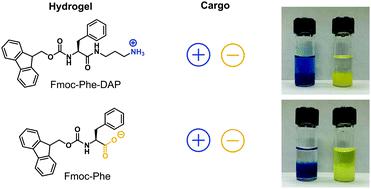当前位置:
X-MOL 学术
›
J. Mater. Chem. B
›
论文详情
Our official English website, www.x-mol.net, welcomes your feedback! (Note: you will need to create a separate account there.)
Electrostatic interactions regulate the release of small molecules from supramolecular hydrogels.
Journal of Materials Chemistry B ( IF 7 ) Pub Date : 2020-06-22 , DOI: 10.1039/d0tb01157f Brittany L Abraham 1 , Ethan S Toriki 1 , N'Dea J Tucker 1 , Bradley L Nilsson 1
Journal of Materials Chemistry B ( IF 7 ) Pub Date : 2020-06-22 , DOI: 10.1039/d0tb01157f Brittany L Abraham 1 , Ethan S Toriki 1 , N'Dea J Tucker 1 , Bradley L Nilsson 1
Affiliation

|
Supramolecular hydrogels have great potential as biomaterials for sustained delivery of therapeutics. While peptide-based supramolecular hydrogels have been developed that show promise for drug delivery applications, the high cost of production has limited their widespread adoption. Low molecular weight (LMW) supramolecular hydrogels are emerging as attractive and inexpensive alternatives to peptide-based hydrogels. We recently reported novel cationic fluorenylmethyloxycarbonyl-modified phenylalanine (Fmoc-Phe) hydrogels for localized and sustained in vivo release of an anti-inflammatory agent for functional pain remediation. In an effort to further elucidate design principles to optimize these materials for delivery of a variety of molecular agents, we herein report a systematic examination of electrostatic effects on the release of cargo molecules from Fmoc-Phe derived hydrogels. Specifically, we interrogate the release of cationic, anionic, and neutral cargo molecules from a series of cationic and anionic Fmoc-Phe derived hydrogels. We observed that cargo was readily released from the hydrogels except when the cargo and hydrogel network had complementary charges, in which case the cargo was highly retained in the network. These results demonstrate that the electrostatic characteristics of both the hydrogel network and the specific cargo are critical design parameters in the formulation of LMW supramolecular hydrogel systems in the development of next-generation materials for drug delivery applications.
中文翻译:

静电相互作用调节小分子从超分子水凝胶中的释放。
超分子水凝胶作为生物材料具有巨大的潜力,可用于持续递送治疗药物。虽然已经开发出基于肽的超分子水凝胶,在药物递送应用方面显示出前景,但高昂的生产成本限制了它们的广泛采用。低分子量 (LMW) 超分子水凝胶正在成为基于肽的水凝胶的有吸引力且廉价的替代品。我们最近报道了新型阳离子芴基甲氧羰基修饰的苯丙氨酸(Fmoc-Phe)水凝胶,用于体内局部和持续释放用于功能性疼痛修复的抗炎剂。为了进一步阐明优化这些材料以输送各种分子试剂的设计原则,我们在此报告了对从 Fmoc-Phe 衍生的水凝胶中释放货物分子的静电效应的系统检查。具体来说,我们从一系列阳离子和阴离子 Fmoc-Phe 衍生的水凝胶中询问阳离子、阴离子和中性货物分子的释放。我们观察到货物很容易从水凝胶中释放出来,除非货物和水凝胶网络具有互补电荷,在这种情况下,货物在网络中高度保留。
更新日期:2020-08-05
中文翻译:

静电相互作用调节小分子从超分子水凝胶中的释放。
超分子水凝胶作为生物材料具有巨大的潜力,可用于持续递送治疗药物。虽然已经开发出基于肽的超分子水凝胶,在药物递送应用方面显示出前景,但高昂的生产成本限制了它们的广泛采用。低分子量 (LMW) 超分子水凝胶正在成为基于肽的水凝胶的有吸引力且廉价的替代品。我们最近报道了新型阳离子芴基甲氧羰基修饰的苯丙氨酸(Fmoc-Phe)水凝胶,用于体内局部和持续释放用于功能性疼痛修复的抗炎剂。为了进一步阐明优化这些材料以输送各种分子试剂的设计原则,我们在此报告了对从 Fmoc-Phe 衍生的水凝胶中释放货物分子的静电效应的系统检查。具体来说,我们从一系列阳离子和阴离子 Fmoc-Phe 衍生的水凝胶中询问阳离子、阴离子和中性货物分子的释放。我们观察到货物很容易从水凝胶中释放出来,除非货物和水凝胶网络具有互补电荷,在这种情况下,货物在网络中高度保留。


























 京公网安备 11010802027423号
京公网安备 11010802027423号